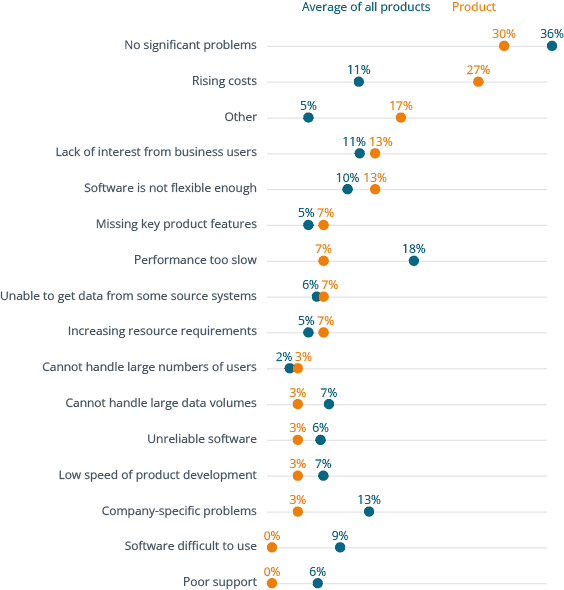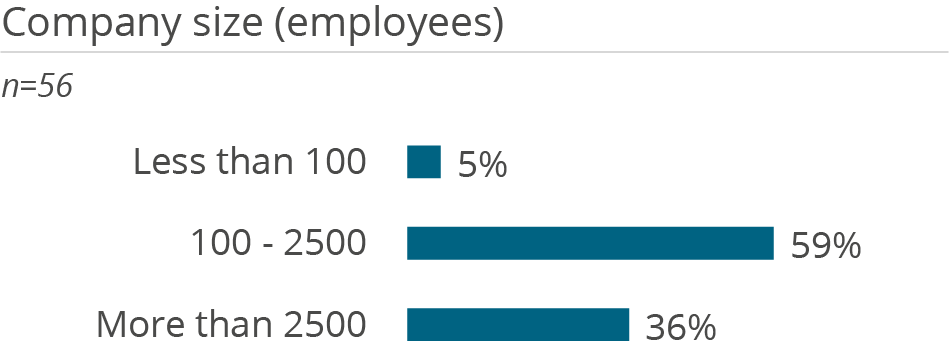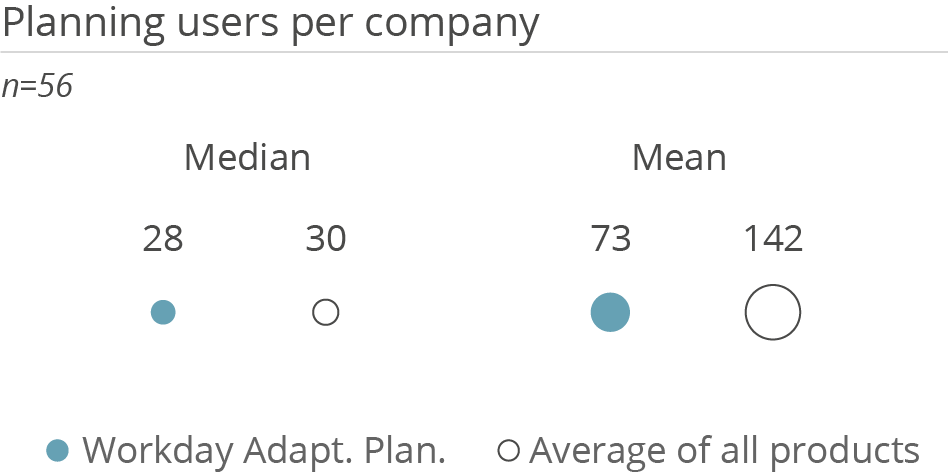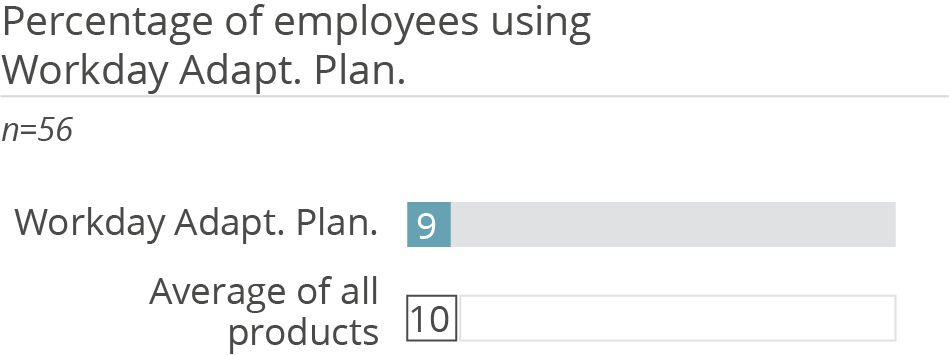
Workday Adaptive Planning
What is Workday Adaptive Planning?
Cloud-based planning and CPM solution with integrated functions for planning, budgeting and forecasting, reporting, dashboarding and analysis
About Workday Adaptive Planning
The information in this section has been provided by the vendor of Workday Adaptive Planning.
Self-description of the vendor
Downloads
Would you like to find out more about BARC reviews? Our FAQs answer the most important questions.
Workday Adaptive Planning BARC Review & Rating
This section contains our independent analyst views on Workday Adaptive Planning.
Provider and product description
Workday is a provider of enterprise cloud applications for finance and human resources used by more than 10,000 organizations of all sizes and in all industries around the world. The company has $8.4 billion in revenue and more than 20,000 employees worldwide. Workday’s portfolio includes applications for financial management, human resources, enterprise planning and analytics. The vendor’s core performance management and analytics offerings are Workday Financial Management, Workday Adaptive Planning and Workday Prism Analytics.
Workday Adaptive Planning was an acquisition to extend Workday’s enterprise planning and CPM capabilities. The flexible and scalable cloud-based platform provides business-user-friendly functionality for various CPM processes, particularly planning, budgeting and forecasting, as well as reporting, analysis and dashboarding. It enables continuous, scenario-based planning across the organization, from enterprise-wide financial planning and analysis to operational planning for specific functions such as workforce, sales, demand and supply, projects and marketing. In addition, Workday Adaptive Planning includes embedded AI/ML capabilities and benefits from Workday’s overall Illuminate AI strategy. Workday Adaptive Planning provides predictive forecasting and anomaly detection, and a Workday Assistant for conversational planning and intelligent variance analysis is in the pipeline. Leveraging generative AI and natural language processing for planning to assist and guide users is a key area of investment for Workday and improves the user experience by making it easier for business users to explore data, test scenarios and gain insights through natural language queries.
Workday Adaptive Planning is used through a fully web-based application that is compatible with popular browsers. Microsoft Office add-ins are available. The platform is built on a multidimensional, in-memory modeling engine (Elastic Hypercube Technology), with data stored relationally in the back end. All calculations and aggregations are performed in-memory. Workday Adaptive Planning enables interoperability and data integration with a wide range of software applications as well as back-end and third-party systems (ERP, CRM, HCM, etc.). Customers have the flexibility to use either the APIs or a purpose-built embedded integration framework (including multiple prebuilt connectors) to manage data integrations.
Workday Adaptive Planning can be used together with the Workday suite of applications or with non-Workday solutions. The vendor’s marketing and sales strategy positions it as a standalone product and offers it as a part of the suite to Workday HCM and Workday Financial Management customers. The vendor will continue to position the product within its existing customer base as a future strategic direction. Customers deploying Workday Adaptive Planning with Workday HCM and/or Workday Financial Management benefit from a unified security and user experience as well as native data management with the ability to drill back to data and master data in the ERP system or publish plans back to Workday core transactional systems. In total, Workday Adaptive Planning is used by approximately 7,000 customers of all sizes across a wide range of industries around the world.
Workday Financial Management provides a full ERP with comprehensive financial and accounting capabilities. For financial consolidation and close, its functionality enables companies to consolidate at the point of transaction. Workday Consolidations consolidates the financial results of subsidiaries into the parent company to create combined financial results. It automatically creates intercompany and eliminating entries across the group. In 2024, a new packaged offering was released that combines all the planning capabilities of Workday Adaptive Planning with the financial consolidation and close capabilities of Workday Financial Management for customers who want to follow an integrated approach.
Complementing the portfolio, Workday Prism Analytics (acquired with Platfora) provides data management and analytics capabilities, including the ability to integrate and ingest operational data and combine it with financial information to drive broader insights and decision-making. Workday Prism Analytics supports an analytics layer that makes Prism data sets discoverable and searchable, combined with core Workday data, and presented in a variety of dashboards and reports.
Strengths and challenges of Workday Adaptive Planning
BARC’s viewpoint on the product’s strengths and challenges.
Strengths
- Workday offers a comprehensive portfolio of enterprise applications for financial management, human resources, enterprise planning and analytics. All products are built on a consistent cloud architecture with an intelligent data core that combines financial and operational data.
- Workday Adaptive Planning is a flexible and scalable cloud-based platform that provides business users with integrated planning, budgeting and forecasting, reporting, analysis and dashboarding capabilities. It can be used together with the Workday suite of applications or standalone with non-Workday solutions.
- Workday Adaptive Planning provides flexibility for a variety of planning approaches (centralized top-down, decentralized bottom-up) and planning topics (including operational planning and financial planning) for organizations of all sizes and industries. It includes built-in financial intelligence with a native understanding of account types such as assets, liabilities, revenues and expenses.
- According to feedback in The Planning Survey, customers are satisfied with Workday’s innovativeness. Many customers are using the product for use cases such as cloud-based planning, driver-based planning and also predictive planning. The product’s win rate in head-to-head evaluations is also excellent.
Challenges
- Workday Adaptive Planning is purely cloud-based and not available on premises. Web access is required to use the product (except for offline planning using Excel templates).
- Unlike previous years, customer feedback in The Planning Survey 25 revealed some dissatisfaction with Workday’s support and the product’s price to value. There are several critical user reviews that express the view that support and implementation assistance from the vendor and its partners is not always satisfactory and has worsened since the Workday acquisition. Perhaps Workday’s growth and continued acquisition of new partners means that the quality of support and partner implementation experience is not at a consistent level. Workday is aware of this and has taken steps to improve and expand its partner ecosystem, launching a new Workday Partner Center to better support its partner and customer community.
- Customer feedback also shows that not all customers are satisfied with the predefined data connectivity and data integration capabilities of Workday Adaptive Planning. Workday provides its own data integration framework and open APIs. In addition, third-party ETL tools can be used, and customers leverage prebuilt adapters to load data from more than 350 unique systems. All integrations (including data mapping and transformation) can be automated to run on a set schedule or manually on demand.
- The majority of Workday Adaptive Planning’s business remains in North America. However, the number of international customers and revenues has increased since the acquisition and Workday is deepening global implementation services and consulting relationships, introducing regional product enhancements, and focusing on increasing brand awareness outside North America. Prospects outside North America should evaluate the vendor’s and partners’ local consulting and support capabilities.
Workday Adaptive Planning User Reviews & Experiences
The information contained in this section is based on user feedback and actual experience with Workday Adaptive Planning.
The information and figures are largely drawn from BARC’s The BI & Analytics Survey, The Planning Survey, The Financial Consolidation Survey and The Data Management Survey. You can find out more about these surveys by clicking on the relevant links.
Who uses Workday Adaptive Planning in a planning context and how
Why users buy Workday Adaptive Planning and what problems they have using it

- Get independent information on software solutions, market developments and trends in data, analytics, business intelligence, data science and corporate performance management.
- Make data & analytics decisions based on numbers, data, facts and expert knowledge
- Access to all premium articles and all our research, including all software comparison studies, scores and surveys.
- Unlimited access to the BARC media library
- Consume unlimited content anywhere
Full user reviews and KPI results for Workday Adaptive Planning
All key figures for Workday Adaptive Planning at a glance.

- Get independent information on software solutions, market developments and trends in data, analytics, business intelligence, data science and corporate performance management.
- Make data & analytics decisions based on numbers, data, facts and expert knowledge
- Access to all premium articles and all our research, including all software comparison studies, scores and surveys.
- Unlimited access to the BARC media library
- Consume unlimited content anywhere
Individual user reviews for Workday Adaptive Planning
Number of employees
Industry
Source
What do you like best?
Drill-down on chosen dimensionality is easy. Building new reports is straightforward, and minor changes can be configured without IT support. The data modeling logic is easy to understand, and downloading and uploading data according to configured templates is simple.
What do you like least/what could be improved?
No financial consolidation by dimensionality. Not enough root accounts to meet our business needs.
What key advice would you give to other companies looking to introduce/use the product?
Be mindful of the root account setup and the limitations of consolidation by dimensionality.
How would you sum up your experience?
-
Number of employees
Industry
Source
What do you like best?
The immediacy of planner inputs being incorporated into consolidated results, whether in the cloud-based platform or the Excel-based Office Connect tool, has been a game-changer for us. The Office Connect plug-in for Excel is a flexible, easy-to-learn, and user-friendly tool that we are very happy with.
What do you like least/what could be improved?
Security settings are difficult to establish, fine-tune, and maintain, and they do not provide the granular level of control that Workday promises. Audit trails are useful when they work, but they are not available in all planning areas, making them another feature that is overpromised but underdelivers. The biggest disappointment is the inability to format planning inputs or implement checks to flag input errors. Columns become unreasonably wide because titles don’t wrap, and blank or nonsensical cells cannot be color-coded or easily identified. This forces users to build Excel reports for reviewing and validating plans, which ultimately defeats the purpose of implementing a cloud-based planning solution.
What key advice would you give to other companies looking to introduce/use the product?
Expect implementation to take longer than promised, regardless of the implementation partner. If your business has complex user security needs, this platform may not be the right fit. Be sure to take advantage of the Administrator Training program.
How would you sum up your experience?
Overall, we like it—it is fast, flexible, and accommodates a variety of planning methods. The financial reporting tools are excellent. However, some key features, such as formatting, audit trails, and comments, are limited to the point of being nearly useless.
Number of employees
Industry
Source
What do you like best?
How it speeds up the month end reporting process and how it holds all data in the same place.
What do you like least/what could be improved?
Rigid reports when you have multiple dimensions and complex coding structure.
What key advice would you give to other companies looking to introduce/use the product?
To ensure your whole team is trained during implementation.
How would you sum up your experience?
Love it!
Number of employees
Industry
Source
What do you like best?
Easy to use for end users with no need for IT support.
What do you like least/what could be improved?
Workday sometimes focuses more on the "next big thing" rather than addressing some of the core functionality issues, such as cross-level journal entries for consolidation.
What key advice would you give to other companies looking to introduce/use the product?
Great tool but ensure you have a good implementation team.
How would you sum up your experience?
Works well and look forward to using some of the new functionality.
Number of employees
Industry
Source
What do you like best?
Flexibility to build models as your business requires.
What do you like least/what could be improved?
Due to its flexibility, it's important to work with a consultant who understands your team size and builds a model that your team can support in the long run. There are also limitations on how you can structure your model, which could impact the software's performance.
What key advice would you give to other companies looking to introduce/use the product?
Do not implement a planning tool at the same time as an ERP - wait until the underlying financial system is stable. Additionally, hire someone internally who understands Adaptive before selecting an implementation partner, as you need to ensure that what you build will work!
How would you sum up your experience?
I really like Adaptive - it has all the requirements of a great planning tool: flexibility, inbuilt AI functionality, and seamless integration with Workday.
Number of employees
Industry
Source
What do you like best?
Simplified approach on planning.
What do you like least/what could be improved?
Expected more standard features and alignment with Workday Financials.
What key advice would you give to other companies looking to introduce/use the product?
Have your finance team at the heart of the project, as they will be the end users and key champions for ongoing improvement.
How would you sum up your experience?
Good, it is still in its early stages, but we can certainly see the positives in the roadmap.
Number of employees
Industry
Source
What do you like best?
The ability to quickly change elements to allow for a single report to be used across multiple entities is a major advantage. The integration with Excel is also a huge plus.
What do you like least/what could be improved?
The limitations around formatting in Office Connect are frustrating. The controls are not very intuitive and take a while to figure out. Can you add an option to round to the nearest whole number? Why is that not an option? Also, it would be helpful to have an editable list of values for a given element that can be embedded in an Office Connect report, similar to the Parameters within the HTML report builder. Repeating reports are not working at all for me. Additionally, some built-in reports, such as a trial balance that lists all the account-level data, would be useful so it doesn’t need to be built by hand.
What key advice would you give to other companies looking to introduce/use the product?
Give yourself time to get acquainted with the software and make sure your reports are accurate before reproducing them or relying on them for decision making.
How would you sum up your experience?
It's a good, useful product that has a significant learning curve for effective use and takes a while to get implemented.
Number of employees
Industry
Source
What do you like best?
The user-friendliness of the tool makes it easier for both the implementor and business stakeholders to develop and use the framework.
What do you like least/what could be improved?
The drill-down functionality can be improved by using cube sheets to reach the lowest level.
What key advice would you give to other companies looking to introduce/use the product?
A goal without a plan is just a wish. Adaptive Planning will make sure that you achieve your goals by better planning.
How would you sum up your experience?
Quite competitive tool and easy to use.
Number of employees
Industry
Source
What do you like best?
It's easy to use. From an administrator standpoint, it's easy to build models without the need of an external consultant. Users are able to pick up on how to use the software without formal training.
What do you like least/what could be improved?
The scalability and performance of the software can be improved upon. Users may experience performance issues if there are too many processes running simultaneously.
What key advice would you give to other companies looking to introduce/use the product?
The software is ideal for companies without complex planning requirements and for smaller teams. If specific planning or reporting requirements need to be met, Adaptive may not always offer a solution or workaround. However, for companies that can work with its out-of-the-box features, it is very easy to use for both users and administrators.
How would you sum up your experience?
I've used Adaptive for many years and I prefer it over other planning software, primarily due to its ease-of-use.
Number of employees
Industry
Source
What do you like best?
Ability to centralise data into a single source.
What do you like least/what could be improved?
The speed of the application is not as quick as I'd hoped, although that could be due to us creating sheets in a non-optimised way.
What key advice would you give to other companies looking to introduce/use the product?
Have a clear implementation plan before you start, and once you're live, keep a clear roadmap of how you plan to continue harvesting as much value from the solution as possible.
How would you sum up your experience?
Very satisfied customer. Workday are a pleasure to work with and deliver on the promises they make.
Number of employees
Industry
Source
What do you like best?
Real-time consolidation, user friendly.
What do you like least/what could be improved?
Reporting and FX conversion flexibility.
What key advice would you give to other companies looking to introduce/use the product?
Overall system is good but if you have heavy reporting and forecasting requirements please make sure you underline them before starting the implementation.
How would you sum up your experience?
Overall system and Workday support is good.
Number of employees
Industry
Source
What do you like best?
It is designed as an end-user tool, albeit with its own quirks. Well-supported product development.
What do you like least/what could be improved?
It is Excel like without being quite like Excel. It is not so good at handling lots of transactions - it is not obviously designed as a data and rules model.
What key advice would you give to other companies looking to introduce/use the product?
Be clear/honest about requirement, and ensure a good match.
How would you sum up your experience?
Within its design parameters it works well. The product support is excellent.
Number of employees
Industry
Source
What do you like best?
The platform integration is better than others we have used.
What do you like least/what could be improved?
There are some limitations with scenarios and functionality.
What key advice would you give to other companies looking to introduce/use the product?
Understand your use cases now and in the foreseeable future.
How would you sum up your experience?
Positive, it is the best tool that is truly integrated.
Number of employees
Industry
Source
What do you like best?
Speed of getting a consolidated result. One standard version of our forecast model.
What do you like least/what could be improved?
Reports are problematic. We use Office Connect reports, but ensuring that everyone is using the same version is difficult. The system reports in Adaptive do not meet our needs visually. Despite a health check from our AMS partner, there are still significant speed issues. FX in consolidation does not work as we need it to—for example, converting YTD results at the YTD rate. Writing formulas is very challenging for a planner, and the data layout in the planning screens is cumbersome.
What key advice would you give to other companies looking to introduce/use the product?
Get Hyperion. Seriously I am a Workday fan, but Adaptive is very poor. It hasn't advanced much since aquisition.
How would you sum up your experience?
It's a poor tool and there are better solutions out there.
Number of employees
Industry
Source
What do you like best?
We moved from weekly forecasting to live forecasting thanks to the integration of our ERP and CRM, combined with automation. This made it possible to build a more complex model while requiring less time and effort. Additionally, the data granularity and the ability to create good, easy-to-build dashboards further enhanced the process.
What do you like least/what could be improved?
Integration part to be easier to maintain/build for non-IT people so anyone could do it.
What key advice would you give to other companies looking to introduce/use the product?
I would totally recommend Adaptive.
How would you sum up your experience?
I really like it.
Number of employees
Industry
Source
What do you like best?
The ability to add code allows for modeling complex scenarios, enabling a range of actions and providing more accurate planning information.
What do you like least/what could be improved?
Some quirkiness in the syntax which is specific to Adaptive Planner.
What key advice would you give to other companies looking to introduce/use the product?
To make sure some staff engage with the training materials offered by Workday.
How would you sum up your experience?
I like it as a planning tool.
Number of employees
Industry
Source
What do you like best?
Flexible product, great customer service and support.
What do you like least/what could be improved?
Sometimes a bit slow load times (complex model).
What key advice would you give to other companies looking to introduce/use the product?
Focus on end-to-end integration across functional organizations. Business is not run in silos, and systems should not be siloed either.
How would you sum up your experience?
Great system.
Number of employees
Industry
Source
What do you like best?
It's Workday and it is all ONE solution.
What do you like least/what could be improved?
Since we implemented, Workday pushed all reporting to be out of Workday, not Adaptive. We've not yet caught up.
What key advice would you give to other companies looking to introduce/use the product?
Plan ahead very carefully, have a bold vision and stick to it mercilessly.
How would you sum up your experience?
Very good, but needs strong ownership and vision.
Number of employees
Industry
Source
What do you like best?
Ease at which users can get used to the system, and ability to integrate with various tactical and strategic solutions as we move through our development cycle.
What do you like least/what could be improved?
Visuals could be enhanced to reduce reliance on Office Connect. Additionally, feedback time and support from the vendor should improve when unexpected performance issues arise.
What key advice would you give to other companies looking to introduce/use the product?
Carefully plan your vision for planning before development to ensure the system is set up correctly, including instances, for future success.
How would you sum up your experience?
Great tool, and we look forward to seeing even more capabilities once Workday Financials and PRISM are live.
Number of employees
Industry
Source
What do you like best?
Easy to implement, great for scenario planning, very scaleable with our business.
What do you like least/what could be improved?
Sometimes technical support queries take a while to be resolved.
What key advice would you give to other companies looking to introduce/use the product?
Strongly consider this solution as the ROI is very high and fast.
How would you sum up your experience?
Excellent.
Number of employees
Industry
Source
What do you like best?
Integration with Workday Financials and HCM (our ERP).
What do you like least/what could be improved?
User interface complexity.
What key advice would you give to other companies looking to introduce/use the product?
There are likely better SaaS tools on the market. If you use Workday as your ERP, Adaptive Planning probably makes sense, but the integration is not as seamless as one might expect.
How would you sum up your experience?
Good to use when you have Workday ERP. Otherwise we would probably use a different tool.
Number of employees
Industry
Source
What do you like best?
Adaptable and has many features.
What do you like least/what could be improved?
Lots of features mean there is a lot to learn. If you don’t know what’s available, you won’t be using the tool to its full potential.
What key advice would you give to other companies looking to introduce/use the product?
Research what the system can do, as its potential is huge—you just need to invest time to unlock it.
How would you sum up your experience?
Very good, flexible and lot's of potential.
Number of employees
Industry
Source
What do you like best?
The robustness of the application and our satisfaction with the product overall is increasing as we get to understand it more.
What do you like least/what could be improved?
The current setup does not lend itself to scenario/ what-if analysis easily.
What key advice would you give to other companies looking to introduce/use the product?
Give adequate time before implementation to establish what you want from the system.
How would you sum up your experience?
Good … and getting better.
Number of employees
Industry
Source
What do you like best?
Its flexibility and drag-drop no-code functionality.
What do you like least/what could be improved?
It needs better integration back into Workday itself - also, more clarity around its use with office connect.
What key advice would you give to other companies looking to introduce/use the product?
It is a separate product and project, so don't try to implement it at the same time as Workday itself.
How would you sum up your experience?
Good system with positive feedback from users.
Number of employees
Industry
Source
What do you like best?
User-friendly, easy to test different scenarios with.
What do you like least/what could be improved?
Since Adaptive was acquired by Workday, the customer service is not as good. Also, the cost has increased substantially.
What key advice would you give to other companies looking to introduce/use the product?
Easy to use and learn.
How would you sum up your experience?
Great.
Number of employees
Industry
Source
What do you like best?
Very scaleable, easy to use, it can report directly out of Excel.
What do you like least/what could be improved?
Make more use of Machine Learning/ AI to assist with budget preparation/ variance analysis.
What key advice would you give to other companies looking to introduce/use the product?
Go for it - you won't regret it! Just remember to document how your budget model works!
How would you sum up your experience?
Very favourable.
Number of employees
Industry
Source
What do you like best?
It is easily accessable, users like it.
What do you like least/what could be improved?
Far too expensive.
What key advice would you give to other companies looking to introduce/use the product?
Make sure you look in the market as there are lots of products out there.
How would you sum up your experience?
Think it is a very powerful tool with lots of functionality, but unless you use the full range of functions, it is very expensive. Think about how Adaptive is going to work with your ERP/FMS.
Number of employees
Industry
Source
What do you like best?
The high flexibility to adjust/ implement new functionalities and logics on your own. As a product (Adaptive) and process owner (Personnel planning and budgeting) of Adaptive, I am able to evolve the tool and integrate everything on my own without the need for external developers.
What do you like least/what could be improved?
The performance on working sheets with a high amount of logics in place can take a hit. Reporting is limited in some aspects.
What key advice would you give to other companies looking to introduce/use the product?
Specifying the use/ business case/ process in the highest detail and as aligned as possible before working on the company-specific setup with the implementing consultant to avoid constant requirement changes during the setup phase. (This should be a given naturally!). By having an Adaptive expert in the company who can bring the tool and accompanying processes forward, it is possible to react quickly to new demands of stakeholders and be independant of external consulting knowledge and support.
How would you sum up your experience?
It's a very user-friendly tool and easy to use, for the single end user as well as for the admin to maintain, while providing flexibility and up-to-date functionalities for all planning purposes.




